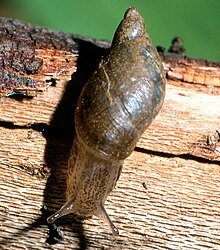| Kanab ambersnail | |
|---|---|

| |
| A Kanab ambersnail at Vasey's Paradise in Grand Canyon National Park. | |
| Scientific classification | |
| Domain: | Eukaryota |
| Kingdom: | Animalia |
| Phylum: | Mollusca |
| Class: | Gastropoda |
| Order: | Stylommatophora |
| Family: | Succineidae |
| Genus: | Oxyloma |
| Species: | |
| Subspecies: | O. h. kanabense
|
| Trinomial name | |
| Oxyloma haydeni kanabense | |

| |
| Habitat of the Kanab ambersnail (marked in orange) | |
| Synonyms | |
|
Oxyloma kanabense Pilsbry, 1948 | |
The Kanab ambersnail, formerly classified as Oxyloma haydeni kanabense or Oxyloma kanabense, is a small, air-breathing land snail belonging to the family Succineidae, the ambersnails. This terrestrial pulmonate gastropod mollusc was previously considered a critically endangered subspecies or species. In 2013, a scientific investigations report by the United States Geological Survey concluded that the Kanab ambersnail is not a genetically distinct species.[2] In June 2021, the Fish and Wildlife Service removed the Kanab ambersnail from the United States Fish and Wildlife Service list of endangered mammals and birds and classified it with other common ambersnails within the same taxa, officially negating its status as a distinct subspecies.[3]
The common name of the amber snails is based on the shell, which is translucent and when empty usually resembles the color of amber.[4]
This snail is endemic to the United States, specifically the states of Arizona and Utah, where it was first collected in the early 20th century. This snail lives in wetlands, springs, and seeps,[5] and only two of its natural habitats are known to exist: Three Lakes, a meadow near Kanab, Utah, and Vasey's Paradise, a springs along the Colorado River within Grand Canyon National Park.[5] In its natural habitat it is rather polyphagous, feeding mainly on bacteria, plants and fungi. It reproduces during the summer.
Previously considered a critically endangered species on the IUCN Red List of Threatened Species[6] due to a series of factors (including anthropic influence[7]), the Kanab ambersnail had been reintroduced to three springs above the historic high water level along the Colorado River.
The snail had been listed as endangered on the United States Fish and Wildlife Service list of endangered species in 1991. In June 2021, following genetic testing that showed it was never a distinct subspecies, the Fish and Wildlife Service delisted the Kanab ambersnail from the federal endangered species list.[8]
- ^ Pilsbry H.A. 1948. Land Mollusca of North America. The Academy of Natural Sciences of Philadelphia Monographs. Vol. II (Part 2): 797-798.
- ^ Culver, Melanie; Herrmann, Hans-Werner; Miller, Mark; Roth, Barry; Sorenson, Jeff (2013). "Anatomical and genetic variation of western Oxyloma (Pulmonata: Succineidae) concerning the endangered Kanab ambersnail (Oxyloma haydeni kanabense) in Arizona and Utah". Anatomical and genetic variation of western Oxyloma (Pulmonata: Succineidae) concerning the endangered Kanab ambersnail (Oxyloma haydeni kanabense) in Arizona and Utah. Scientific Investigations Report. Vol. Scientific Investigations Report. U.S. Geological Survey. pp. 45–78. doi:10.3133/sir20135164. Retrieved 23 October 2023.
- ^ Final Rule: Removing the Kanab Ambersnail From the List of Endangered and Threatened Wildlife, 86 FR 33138 (June 24, 2021).
- ^ "Mollusks". Grand Canyon National Park. Archived from the original on 2007-09-28. Retrieved 2006-11-25.
- ^ a b Jeff Sorensen. "Kanab Ambersnail (Oxyloma haydeni kanabensis)". gf.state.az.us. Archived from the original on 2006-10-04. Retrieved 2006-11-26.
- ^ Roth, B (1996). "Oxyloma kanabense". IUCN Red List of Threatened Species. 1996: e.T15780A5148979. doi:10.2305/IUCN.UK.1996.RLTS.T15780A5148979.en.
- ^ Cite error: The named reference
Randall2k3was invoked but never defined (see the help page). - ^ "Advances in Genetic Research Reveal Kanab Ambersnail Not a Distinct Subspecies". U.S. Fish and Wildlife Service Mountain-Prairie Region. Retrieved 1 December 2021.